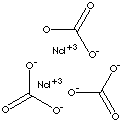PRODUCT IDENTIFICATION

Nd2(CO3)3·H2O
HS CODE
CLASSIFICATION
PHYSICAL AND CHEMICAL PROPERTIES
114 C
AUTOIGNITION
NFPA RATINGS
REFRACTIVE INDEX
EXTERNAL LINKS & GENERAL DESCRIPTION
USA.gov - Neodymium carbonate
Wikipedia Linking - Neodymium
Google Scholar Search - Neodymium carbonate
U.S. National Library of Medicine - Neodymium carbonate
PubChem Compound Summary - Neodymium carbonate
NCBI (http://www.ncbi.nlm.nih.gov/) - Neodymium carbonate
Material Safety Data Sheet - Neodymium carbonate
Local:
Neodymium is a lustrous, silver-yellow, rare-earth metallic element in the lanthanide series of group IIIb of the periodic table. Symbol Nd; Aomic number 60; atomic mass 144.24; melting point ca 1,021°C; boiling point ca 3,068°C; specific gravity 6.80 or 7.004; valence +3; electronic config. [Xe]4f46s². Neodymium tarnishes in air, forming an oxide form that splits and exposes to further oxidation. The coated form does not protect the metal from further oxidation (it must be stored away from contact with air). The metal is also attacked by water and by acids. Thought it has a hexagonal crystalline structure, but it assumes a face-centered cubic conformation with specific gravity about 6.8 when heated above 800°C. Neodymium is not found in nature as the free element but in the minerals monazite and bastnasite. The metal may be prepared from electrolysis of its halides or through an ion exchange process. Neodymium is used in coloring glasses and for doping some glass lasers since it transmits 90% of the blue, green, and red light rays and no more than 10% of the yellow. Neodymium compounds include:
- Neodymium Acetate (CAS #: 25721-92-0, Nd(C2H3O2)3)
- Neodymium Bromide (CAS #: 13536-80-6, NdBr3)
- Neodymium Carbonate Hydrate (CAS #: 38245-38-4, Nd2(CO3)3)·XH2O)
- Neodymium Chloride (CAS #: 10024-93-8, NdCl3 or 13477-89-9 (Hexahydrate))
- Neodymium Fluoride (CAS #: 13709-42-7, NdF3)
- Neodymium Hydroxide Hydrate (16469-17-3, Nd(OH)3·XH2O)
- Neodymium Iodide (CAS #: 13813-24-6, NdI3)
- Neodymium Nitrate Hydrate(CAS #: 14517-29-4, Nd(NO3)3)·XH2O)
- Neodymium Nitride (NdN)
- Neodymium Oxalate Hydrate (28877-87-4, Nd2(C2O4)3·XH2O)
- Neodymium Oxide (CAS #: 1313-97-9, Nd2O3)
- Neodymium Sulfate Hydrate (101509-27-7, Nd2(SO4)3·XH2O)
- Neodymium Sulfide (Nd2S3 )
- Neodymium Telluride (CAS #: 12035-35-7, Nd2Te3)
APPEARANCE
90.0, 99.0, 99.9%, 99.999%%
Nd2(CO3)3)·XH2O
44.0 ~ 65.0%
HAZARD OVERVIEW
GHS (Globally Harmonised System) Classification: Skin irritation. Eye irritation; Specific target organ toxicity - single exposure. Hazard statements: Causes skin irritation. Causes serious eye irritation. May cause respiratory irritation..
GHS
Warning
PICTOGRAMS

HAZARD STATEMENTS
H315-H319-H335
P STATEMENTS
P261-P305 + P351+ P338
![]()
RISK PHRASES
36/37/38
SAFETY PHRASES
26-36